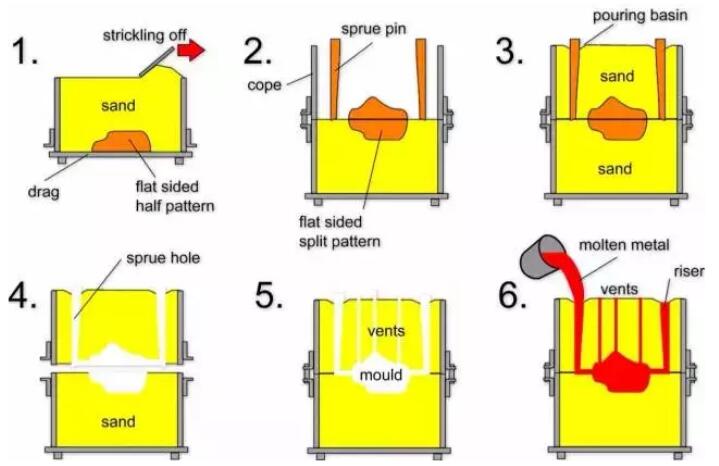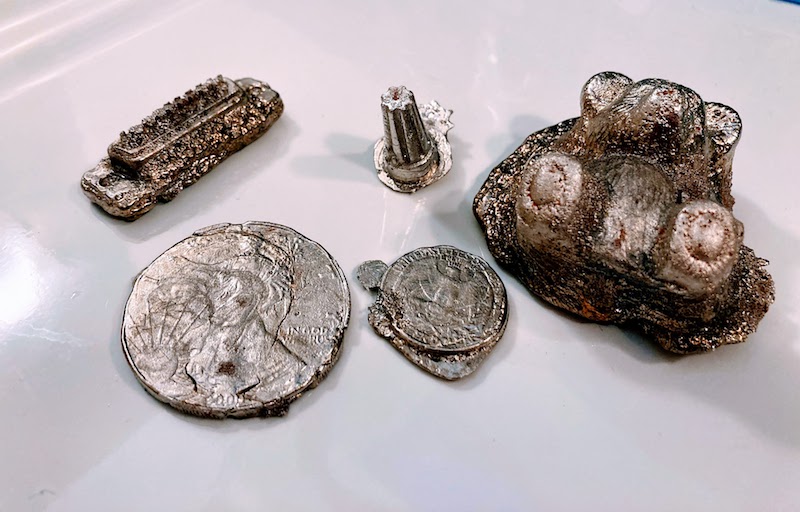The science of Aluminum Foundry and its role in sustainable manufacturing
Recognizing the Metal Castings Refine: A Comprehensive Guide for Beginners
The Metal Casting procedure is a fundamental method in making that transforms molten steel right into solid types. Beginners should comprehend the various techniques included, such as sand spreading and die spreading. Recognizing the products, design concepts, and safety actions is similarly essential. Each facet plays a critical function in achieving successful outcomes. As one navigates these details, the inquiry of how to enhance each action for enhanced results becomes progressively significant.
The Fundamentals of Metal Casting
Although Metal Casting has progressed over centuries, its basic principles stay consistent and indispensable to the manufacturing process. At its core, Metal Casting entails the transformation of molten metal into strong things via various strategies. The process begins with the development of a mold, which specifies the shape of the last item. Once the mold is prepared, steel is heated up to its melting point and put into the tooth cavity. After cooling, the metal strengthens, taking the shape of the mold and mildew.
There are numerous casting methods, including sand spreading, financial investment spreading, and pass away spreading, each with unique advantages and applications. The choice of method depends upon elements such as manufacturing volume, material kind, and wanted accuracy. When cast, the last product might undertake added processes like machining or surface area treatment to achieve the needed coating and requirements. Comprehending these fundamentals is essential for anybody thinking about the field of Metal Casting.

Comprehending Products Used in Metal Casting
Materials play a vital duty in the Metal Casting procedure, affecting the end product's buildings and performance. Different metals are made use of, including light weight aluminum, iron, steel, and bronze, each offering distinctive attributes matched for details applications. Aluminum is corrosion-resistant and light-weight, making it perfect for automobile parts. Iron, particularly cast iron, is preferred for its exceptional wear resistance and toughness. Steel offers high toughness and versatility, often utilized in heavy equipment parts. Bronze, known for its corrosion resistance and machinability, is commonly used in marine applications.
In addition to the metals, different casting products, such as sand, plaster, and ceramic, are used to develop mold and mildews. Sand casting, one of the most widespread approach, makes use of silica sand due to its thermal security and capacity to create complex forms. Plaster and ceramic mold and mildews provide better information but might require even more complicated procedures. The choice of products straight impacts the efficiency, expense, and high quality of the casting procedure.
The Layout Process: From Idea to Blueprint
The style process in Metal Casting starts with the preliminary principle development, where concepts are created and examined. This is followed by the application of CAD modeling techniques, permitting exact visualizations of the style. The plan finalization steps guarantee that all requirements are precisely documented for production.
Initial Idea Advancement
First concept advancement marks a crucial stage in the Metal Casting procedure, where concepts change right into concrete designs. During this stage, designers work together with stakeholders and designers to brainstorm and fine-tune first principles. They take into consideration elements such as capability, looks, and manufacturability, ensuring that the style fulfills the called for specifications and efficiency requirements. Sketches and outlines are produced to imagine the concepts, enabling for initial evaluations of feasibility and cost-effectiveness. This phase also includes identifying products and prospective casting methods that straighten with the layout objectives. Inevitably, first idea development lays the foundation for a detailed blueprint, leading the succeeding stages of the spreading process and making sure an effective change from concept to reality.
CAD Modeling Techniques
Changing concepts right into exact styles, CAD modeling strategies play an essential role in the Metal Casting procedure. These methods utilize advanced software program to create in-depth three-dimensional versions that properly show the intended item. By using devices such as parametric modeling, solid modeling, and surface modeling, developers can manipulate measurements and forms with convenience. CAD systems also help with simulation and evaluation, permitting the recognition of prospective defects before manufacturing begins. This aggressive method lowers product waste and enhances the style for manufacturability. Additionally, CAD models can be quickly modified, allowing quick iterations based on responses. Essentially, CAD modeling works as the foundation of the layout procedure, connecting the space between first concepts and the ultimate production-ready layouts.
Plan Completion Steps
Following the development of in-depth CAD versions, the following stage entails plan completion, which is vital in converting electronic designs into workable strategies for manufacturing. This process starts with assessing the CAD designs for precision and conformity with specifications. As soon as validated, the dimensions, tolerances, and material requirements are thoroughly outlined to guarantee quality. Incorporating notes and comments aids interact necessary info regarding casting processes, surface area coatings, and setting up demands. The wrapped up blueprint undergoes an extensive approval procedure, often entailing collaboration with engineers and production teams to resolve any possible issues. Nevertheless modifications are made and authorizations obtained, the plan is officially released, working as the foundational paper for the succeeding phases of Metal Casting, consisting of pattern production and mold layout.
The Steel Casting Strategies Explained

Metal Casting methods encompass a range of techniques made use of to shape molten metal right into desired forms. These techniques differ according to the kind of material, complexity of the style, and production volume. Sand spreading is one of the most common approaches, entailing the development of a mold from sand to hold the liquified steel. Investment spreading, or lost-wax casting, enables elaborate designs by utilizing a wax pattern that is dissolved. Pass away casting utilizes high-pressure injection of liquified steel right into a mold, suitable for mass production. Other methods include long-term mold casting, which utilizes reusable molds, and centrifugal casting, where rotational forces help in Learn More filling up the mold. Each method has its benefits and applications, making it essential for producers to pick the ideal method based upon their particular demands and needs. Understanding these strategies is vital for anybody entailed in the Metal Casting process.
Finishing Procedures: Enhancing Your Casted Product

Finishing processes play an essential role in improving the high quality and appearance of casted products. Various surface treatment strategies, such as sprucing up and layer, are employed to enhance resilience and aesthetic appeals. In addition, quality examination approaches guarantee that the final product meets defined criteria and performance requirements.
Surface Area Therapy Methods
A selection of surface therapy strategies play a necessary role in boosting the top quality and durability of casted products. These methods include approaches such as shot blasting, polishing, that site and covering. Shot blowing up properly removes surface area imperfections, improving the useful and visual qualities of the casting. Polishing supplies a smooth surface, which is especially essential for ornamental applications and elements needing very little friction. Finishing strategies, such as electroplating or powder covering, offer additional security versus corrosion and wear, making certain resilience. Furthermore, surface treatments can improve bond for subsequent processes, such as painting or bonding. By utilizing these methods, makers can accomplish remarkable surface area high quality, which is critical for the efficiency and lifespan of Metal Casting in various applications.
Quality Evaluation Methods
Reliable quality examination approaches are crucial for guaranteeing the stability and performance of casted products after the finishing processes. Numerous strategies are used to assess the quality of Metal Casting, consisting of visual assessment, dimensional checks, and non-destructive testing (NDT) Visual assessment permits the identification of surface area flaws, while dimensional checks assure that products fulfill defined tolerances. NDT methods, such as ultrasonic screening and radiographic assessment, supply much deeper insights into interior integrity without harming the spreadings. Furthermore, mechanical screening, such as tensile and firmness tests, evaluates material buildings - Aluminum Foundry. look here By utilizing a mix of these approaches, producers can improve item high quality and integrity, eventually causing higher customer satisfaction and decreased manufacturing costs
Safety And Security Considerations in Metal Casting
While the Metal Casting process provides various benefits, it additionally presents a variety of safety threats that should be meticulously taken care of. Employees in casting centers are exposed to heats, liquified steels, and hazardous products, which can result in serious injuries if correct precautions are not taken. Personal safety tools (PPE) such as heat-resistant handwear covers, deal with shields, and protective clothing is vital to minimize risks.
Additionally, the visibility of fumes and dirt demands proper ventilation systems to ensure air top quality - Aluminum Foundry. Regular training on safety and security procedures is essential for all staff members to acknowledge prospective hazards and react successfully. Emergency treatments ought to be established, consisting of fire precaution and first aid availability. Maintenance of devices and correct handling of products additionally add to a more secure working environment. By prioritizing these safety considerations, Metal Casting operations can secure their labor force and keep reliable manufacturing processes
Frequently Asked Inquiries
What Are the Environmental Influences of Metal Casting?
Metal Casting can lead to environmental impacts such as air and water contamination, source exhaustion, and energy consumption. In addition, incorrect waste monitoring and emissions from shops add to eco-friendly disruptions and health and wellness threats for neighboring communities.
How Do I Choose the Right Steel for Casting?
To pick the ideal steel for casting, one must think about elements such as mechanical residential or commercial properties, rust resistance, thermal conductivity, and cost. Examining the designated application and environmental problems is essential for ideal choice.
What Are the Typical Defects in Metal Casting?
Typical problems in Metal Casting include porosity, contraction, sand incorporation, and misruns. These concerns usually occur from improper material choice, poor design, or imperfections in the casting process, influencing the last product's quality and efficiency.
How Can I Improve My Metal Casting Abilities?
To improve Metal Casting skills, one need to practice constantly, study spreading strategies, evaluate previous projects for problems, look for feedback from experienced casters, and constantly experiment with various materials and approaches to boost proficiency and understanding.
What Is the Cost of Beginning a Metal Casting Company?
Beginning a metal spreading business normally needs an initial investment of $5,000 to $50,000, depending on devices, materials, and center expenses. Factors like location and scale can greatly influence general startup expenses.
The Metal Casting process is a basic method in making that changes molten metal into solid kinds. Novices must grasp the various approaches included, such as sand spreading and pass away casting. There are a number of casting methods, consisting of sand casting, financial investment casting, and pass away spreading, each with unique advantages and applications. Investment spreading, or lost-wax casting, permits for complex layouts by utilizing a wax pattern that is thawed away. Various other techniques include permanent mold and mildew spreading, which uses recyclable mold and mildews, and centrifugal spreading, where rotational forces assist in filling the mold.